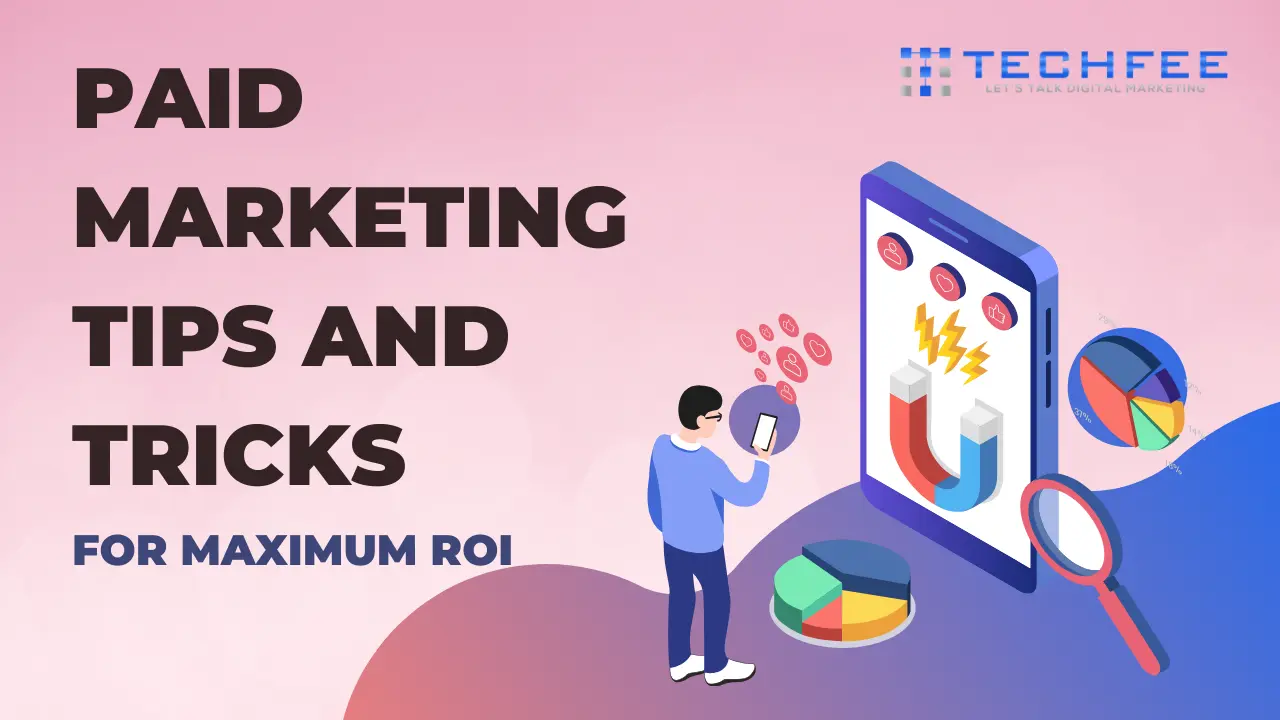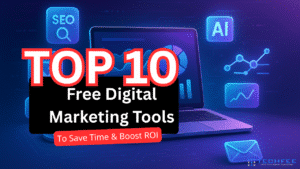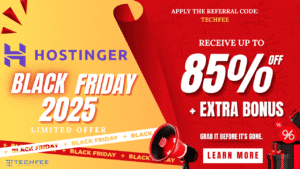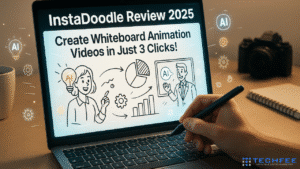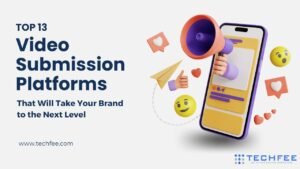Paid marketing is no longer just a choice in today’s fast-paced digital world; it’s a must for businesses that want to do well in a competitive field.
Organic reach keeps going down, but paid marketing is still the most effective way to get instant visibility, targeted reach, and results that can be measured.
No matter how long you’ve been marketing or how new you are to it, learning the ins and outs of paid marketing can open up growth options you never thought possible.
Set up your first paid campaign and learn about the newest trends, such as AI-driven advertising, voice search, and engaging ads.
According to Statista, It was calculated that the digital advertising spending worldwide amounted to 549.51 billion U.S. dollars in 2022. The source projected that by 2027, the spending would reach 870.85 billion dollars.
This complete guide will teach you everything you need to know. As privacy laws get stricter and customer habits change, it’s important to stay on top of these changes.
Check it out to learn how to use paid marketing to not only keep up with these changes but also take your brand to new heights.
Understanding Paid Marketing
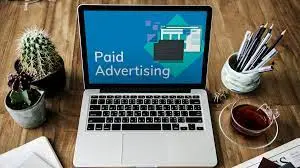
What is Paid Marketing?
Paid marketing is a strategy for getting your brand, goods, or services in front of specific people by using paid channels.
Paid marketing, on the other hand, uses paid methods like ads to get your message in front of potential customers.
Organic marketing, on the other hand, uses free methods like SEO and content marketing.
Paid marketing includes a lot of different types, like search engine ads, social media ads, display ads, influencer marketing, and more.
Businesses can quickly become known, get more visitors, and get new leads by paying for ads to show up on sites where their ideal customers are most likely to be.
Paid marketing and spontaneous marketing are very different from each other.
Paid marketing, on the other hand, lets businesses reach their target audience right away, while organic marketing takes time to build a brand through good content, SEO, and engagement.
Organic marketing may take longer to see results, but it often builds trust and influence over time.
Paid marketing, on the other hand, is made to get results quickly, which makes it perfect for projects that need to reach their goals quickly.
One of the best things about paid marketing is that you can see results right away. Your ads can start getting clicks, leads, and sales as soon as your campaign goes live.
This makes it a great choice for businesses that want to quickly improve their online presence. Paid marketing also lets you reach very specific people.
You can be very specific about demographics, hobbies, behaviors, and even locations with advanced targeting options. This way, you can make sure that your ads are seen by the right people.
Benefits of Paid Marketing
One more benefit of paid marketing is that it can be measured. Paid marketing gives you detailed analytics and reporting tools that let you keep an eye on every part of your campaign, unlike some organic methods where it can be hard to measure results.
You can see impressions, clicks, conversions, and ROI in real time, which lets you make decisions based on data to make your ads more effective.
Lastly, paid marketing gives you the most freedom and ability to grow.
You can easily change your budget, targeting, and ad creatives as needed, whether you’re running a small campaign with a small budget or a large operation across many platforms.
Because it’s scalable, businesses of all kinds can make their paid marketing fit their needs, making sure that every dollar spent helps them reach their marketing goals.
Organic vs. Paid Marketing: Four Key Differences
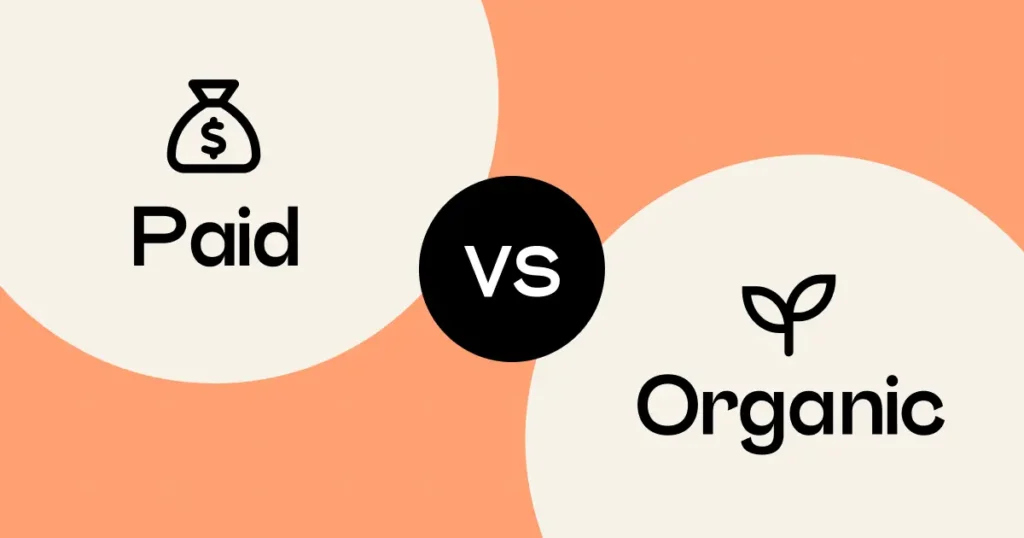
1. Organic Marketing Relies on Non-Paid Strategies
Organic marketing is centered around strategies that don’t require direct payment for visibility.
Instead, it focuses on building a brand’s presence through content creation, search engine optimization (SEO), social media engagement, and community building.
The goal is to naturally attract and engage an audience by offering valuable and relevant content. This process is gradual and often requires patience, as it involves establishing a long-term relationship with your audience, fostering trust, and positioning your brand as an authority in your industry.
Organic marketing is a foundational approach that supports sustainable growth over time without the need for continuous financial investment.
2. Paid Marketing Can Deliver Faster Results
One of the most significant advantages of paid marketing is its ability to produce quick results.
By utilizing paid channels such as Google Ads, Facebook Ads, or display advertising, businesses can immediately reach their target audience and drive traffic, leads, or sales.
Unlike organic strategies, which can take months to build momentum, paid marketing campaigns can start generating results as soon as they go live.
This speed makes paid marketing particularly useful for time-sensitive campaigns, product launches, or any scenario where immediate visibility is crucial.
The ability to quickly scale and adjust campaigns also adds to the efficiency of paid marketing.
3. Organic Marketing Can Deliver Longer-Lasting Results
While paid marketing is effective for short-term gains, organic marketing shines in delivering long-lasting results.
Content created for organic marketing, such as blog posts, infographics, or social media updates, continues to attract and engage users long after it has been published.
This evergreen content can rank well on search engines for months or even years, consistently bringing in traffic without additional investment.
The gradual and cumulative nature of organic marketing means that, over time, your content library grows, enhancing your brand’s visibility and authority. This sustained presence is a key benefit of organic marketing, as it supports continuous growth without the need for ongoing ad spend.
4. Organic Marketing Benefits From the ‘Trust Factor’
A significant advantage of organic marketing is the ‘trust factor’ it inherently carries. Consumers often perceive organically discovered content as more credible and authentic compared to paid advertisements.
Since organic marketing is not overtly promotional, it is often seen as more genuine, which helps build trust with your audience. This trust can lead to higher engagement rates, stronger customer relationships, and greater brand loyalty.
While paid ads are sometimes met with skepticism, organically ranked content and user-generated endorsements are often viewed as more reliable sources of information, giving your brand a more trustworthy image in the eyes of consumers.
Setting Up a Paid Marketing Strategy
Identifying Your Goals
Before diving into paid marketing, it’s essential to identify clear and specific goals that will guide your strategy.
Typically, businesses focus on three primary objectives: brand awareness, lead generation, and sales and conversions.
Brand Awareness: If your goal is to increase brand recognition, your paid marketing efforts should aim to reach a broad audience. This might involve using display, social media, or video ads to introduce your brand to potential customers. The key here is to ensure your brand message resonates with the audience, making it memorable and establishing a presence in the market.
Lead Generation: For businesses looking to capture potential customers’ information for future marketing efforts, lead generation is the focus. Paid campaigns can be designed to drive traffic to landing pages where users are encouraged to provide their contact information in exchange for something valuable, like a free eBook, webinar, or consultation. The goal is to build a database of prospects that can be nurtured over time.
Sales and Conversions: If your primary goal is to drive sales, your paid marketing strategy should be focused on converting prospects into paying customers. This might involve using search engine ads, remarketing campaigns, or shopping ads that target users further down the sales funnel. The focus here is on optimizing ad copy, visuals, and calls-to-action to encourage immediate purchases or sign-ups.
Budgeting for Paid Marketing
Once your goals are identified, the next step is to determine your budget and allocate it effectively across different channels.
Determining Your Budget: Start by assessing how much you’re willing to invest in your paid marketing efforts. This involves considering your overall marketing budget, the cost-per-click (CPC) or cost-per-thousand-impressions (CPM) rates for your chosen platforms, and the expected return on investment (ROI). It’s crucial to balance your budget to ensure that it aligns with your business goals and financial capacity.
Allocating Funds Across Channels: After determining your budget, the next step is to allocate funds across the various paid marketing channels. Depending on your goals, you might choose to invest more heavily in certain platforms. For instance, if brand awareness is your goal, you might allocate more funds to social media and display advertising. If you’re focusing on lead generation or conversions, search engine ads or targeted social media ads might require a larger portion of the budget. It’s important to continuously monitor and adjust your allocations based on the performance of each channel to maximize your ROI.
Defining Your Target Audience
A successful paid marketing strategy hinges on accurately defining and understanding your target audience. This involves analyzing demographics, psychographics, and behaviors to ensure your ads reach the right people.
Demographic Analysis: Start by identifying the basic demographic characteristics of your target audience, such as age, gender, location, income level, and education. This information helps in crafting ad messages that resonate with specific groups and choosing the right platforms for your campaigns. For example, younger audiences might be more active on platforms like Instagram or TikTok, while older professionals might be better reached through LinkedIn.
Psychographic Insights: Beyond demographics, understanding the psychographics of your audience is crucial. This includes analyzing their interests, values, lifestyles, and motivations. Psychographic insights help in creating more personalized and emotionally resonant ads that connect with your audience on a deeper level. For example, if your target audience values sustainability, you might highlight the eco-friendly aspects of your products in your ads.
Behavioral Targeting: Finally, behavioral targeting allows you to reach users based on their online behaviors, such as past purchases, browsing history, or interactions with your brand. By leveraging data on user behavior, you can create highly targeted ads that appeal to users at different stages of the buyer’s journey. For instance, if a user has visited your product page multiple times without making a purchase, you can target them with a special offer to encourage conversion. This level of targeting increases the relevance of your ads, leading to higher engagement and better results.
Key Paid Marketing Channels
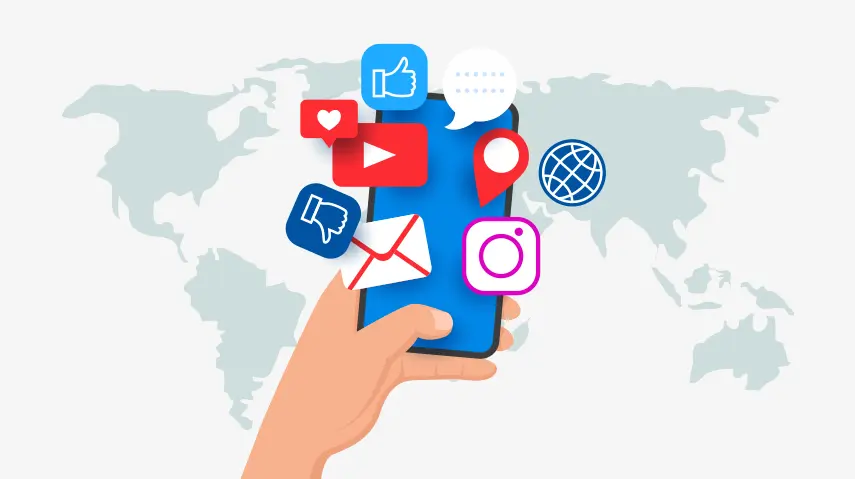
Search Engine Advertising
Google Ads: Google Ads is the most popular platform for search engine advertising, allowing businesses to display their ads to users who are actively searching for related keywords on Google.
With its vast reach and robust targeting options, Google Ads offers a variety of ad formats, including text ads, shopping ads, and video ads on YouTube.
By bidding on relevant keywords, you can ensure that your ads appear at the top of search engine results pages (SERPs), driving highly targeted traffic to your website.
Bing Ads: While not as dominant as Google, Bing Ads (now Microsoft Advertising) is a valuable platform for reaching a different segment of search engine users.
Bing powers searches on Bing, Yahoo, and AOL, giving your ads exposure across multiple networks.
Bing Ads can be particularly effective for reaching older, more affluent audiences, and it often has lower competition and cost-per-click (CPC) rates than Google Ads.
Utilizing both Google and Bing Ads can help you maximize your reach and capture more search traffic.
Social Media Advertising
Facebook Ads: Facebook Ads is a versatile platform that allows businesses to target users based on demographics, interests, behaviors, and more.
With a variety of ad formats, including image ads, video ads, carousel ads, and slideshow ads, Facebook Ads is ideal for promoting products, services, or content.
The platform’s advanced targeting and retargeting capabilities make it a powerful tool for driving brand awareness, lead generation, and conversions.
Instagram Ads: Owned by Facebook, Instagram Ads leverages the same robust targeting options while focusing on visually-driven content.
Instagram is particularly effective for reaching younger audiences and industries that thrive on visual appeal, such as fashion, beauty, travel, and lifestyle.
Ad formats include photo ads, video ads, carousel ads, and Stories ads, allowing brands to create immersive and engaging campaigns that resonate with users.
Twitter Ads: Twitter Ads enable businesses to promote tweets, accounts, or trends to reach a broader audience on the platform.
With targeting options that include keywords, interests, and follower lookalikes, Twitter Ads can be used to drive brand awareness, engagement, and website traffic.
The platform’s real-time nature makes it an excellent choice for promoting time-sensitive offers, events, or content.
LinkedIn Ads: LinkedIn Ads is the go-to platform for B2B marketing, offering highly targeted options based on job title, industry, company size, and more.
LinkedIn Ads can help you reach decision-makers, professionals, and businesses with Sponsored Content, InMail, and text ads.
Whether you’re promoting thought leadership content, generating leads, or driving event registrations, LinkedIn Ads is an effective way to connect with a professional audience.
TikTok Ads: TikTok Ads is a newer platform that has quickly become a powerful tool for reaching younger audiences, particularly Gen Z.
With its focus on short, creative video content, TikTok Ads allows brands to create engaging and viral campaigns.
Ad formats include in-feed ads, branded hashtags, and branded effects, providing opportunities for brands to connect with users in an authentic and entertaining way.
Display Advertising
Banner Ads: Banner ads are one of the most traditional forms of online advertising, displayed as rectangular graphics on websites across the internet.
These ads can be static or animated and are typically used to drive brand awareness or traffic to a specific landing page.
Banner ads are often placed on high-traffic websites to reach a broad audience and can be targeted based on user demographics, interests, or browsing behavior.
Video Ads: Video ads are a powerful way to engage users with dynamic content that captures their attention.
These ads can be displayed on platforms like YouTube, social media, or within articles on various websites.
Video ads are particularly effective for storytelling, product demonstrations, and creating emotional connections with the audience.
They can be skippable or non-skippable and are often used to drive brand awareness, engagement, and conversions.
Native Ads: Native ads blend seamlessly with the content of the website or platform they appear on, making them less intrusive and more engaging.
These ads are designed to match the look and feel of the surrounding content, which can lead to higher engagement rates.
Native ads can appear as sponsored articles, in-feed ads on social media, or recommended content at the end of blog posts.
They are particularly effective for content marketing and driving traffic to educational or promotional content.
Influencer Marketing
Selecting the Right Influencers:
Influencer marketing involves partnering with individuals who have a significant following on social media or other platforms to promote your brand or products.
Selecting the right influencers is crucial to the success of your campaign.
It’s important to choose influencers whose audience aligns with your target demographic, and who share your brand’s values and message.
Consider factors such as audience engagement, authenticity, and the influencer’s niche when making your selection.
Measuring ROI:
Measuring the return on investment (ROI) of influencer marketing can be challenging but is essential to determine the effectiveness of your campaign.
Key metrics to track include engagement rates, reach, website traffic, and conversions driven by the influencer’s content.
Using unique discount codes, tracking links, or affiliate programs can help you attribute sales directly to the influencer’s efforts.
Regularly analyzing these metrics allows you to adjust your strategy and maximize the impact of your influencer partnerships.
Affiliate Marketing
Setting Up an Affiliate Program:
Affiliate marketing involves partnering with individuals or other businesses who promote your products or services in exchange for a commission on sales generated through their referrals.
Setting up an affiliate program requires creating a structure that outlines commission rates, terms, and conditions, and providing affiliates with the tools and resources they need to promote your brand.
This might include banners, product links, and promotional guidelines.
Choosing Affiliates:
Choosing the right affiliates is key to a successful program.
Look for affiliates who have a strong online presence, a relevant audience, and a proven track record in promoting products similar to yours.
It’s important to ensure that affiliates align with your brand values and that their promotional methods are consistent with your marketing goals.
Building strong relationships with your affiliates can lead to more effective promotion and better overall results.
Tracking and Payments:
Tracking the performance of your affiliates and managing payments is an essential part of running an affiliate program.
Use tracking software to monitor clicks, conversions, and sales generated by each affiliate.
This data helps you assess the effectiveness of your affiliates and adjust your strategy as needed.
Payments should be handled transparently and promptly, based on the agreed-upon commission structure. Offering incentives for top-performing affiliates can also encourage them to continue promoting your brand effectively.
Creating Effective Ad Campaigns
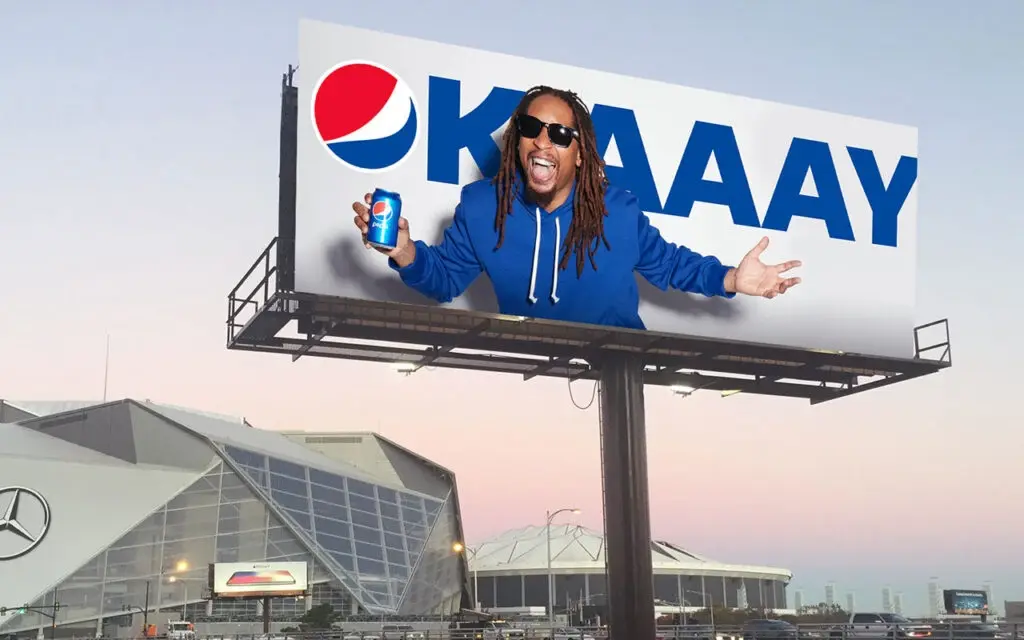
Crafting Compelling Ad Copy
Headlines:
The headline is often the first thing that catches a user’s attention, making it a critical component of your ad copy.
A powerful headline should be concise, attention-grabbing, and directly relevant to the user’s needs or interests.
It should clearly convey the value proposition and include strong, action-oriented language.
Personalization, such as addressing the audience directly or using questions, can also increase engagement.
The goal is to create a headline that compels users to learn more by clicking on your ad.
Descriptions:
The description in your ad copy provides additional details that support the headline and entice users to take action.
It should highlight the key benefits of your product or service, address potential pain points, and include relevant keywords for better targeting.
The description should be clear, concise, and persuasive, emphasizing what makes your offering unique.
Including social proof, such as customer testimonials or ratings, can also enhance credibility and appeal.
Call-to-Action (CTA):
The Call-to-Action is a crucial element of your ad copy that directs users on what to do next.
A strong CTA should be clear, direct, and action-oriented, encouraging users to take the desired step, whether it’s making a purchase, signing up for a newsletter, or downloading a resource.
Phrases like “Shop Now,” “Get Started,” “Sign Up Today,” or “Learn More” can create a sense of urgency and drive immediate action. Customizing the CTA to align with the ad’s goal and the audience’s needs can significantly improve conversion rates.
Designing Engaging Visuals
Image Ads:
Image ads are a staple in paid marketing, offering a simple yet effective way to capture attention.
The design should be visually appealing, with high-quality images that resonate with your target audience.
The imagery should be relevant to your product or service and align with your brand’s aesthetic.
Including your logo and a clear CTA within the image can reinforce brand recognition and encourage action.
The key is to create visuals that stand out while conveying your message quickly and effectively.
Video Ads:
Video ads are increasingly popular due to their ability to tell a story and engage users more deeply than static images.
Effective video ads should be concise, capturing attention within the first few seconds.
The content should be dynamic, with a strong narrative that highlights the benefits of your product or service.
Consider incorporating testimonials, demonstrations, or behind-the-scenes content to build trust and authenticity.
Ensure that the video is optimized for different platforms and includes captions, as many users watch videos without sound.
Carousel Ads:
Carousel ads allow you to showcase multiple images or videos within a single ad, giving users a more interactive experience.
Each card in a carousel can highlight a different product, feature, or benefit, making it ideal for product collections or storytelling.
The design should be cohesive, with each card contributing to the overall narrative.
Use clear, compelling headlines and CTAs on each card to guide users through the carousel and encourage engagement.
Carousel ads are particularly effective on platforms like Facebook and Instagram, where users are accustomed to swiping through content.
Landing Pages and Conversion Optimization
Designing High-Converting Landing Pages:
A well-designed landing page is crucial for converting ad clicks into leads or sales.
The landing page should be directly relevant to the ad, providing a seamless experience from the moment the user clicks.
It should have a clear, compelling headline that matches the ad copy, along with concise, benefit-driven content that guides the user toward the desired action.
The design should be clean and uncluttered, with a strong visual hierarchy that highlights the CTA.
Fast loading times, mobile responsiveness, and trust signals like testimonials or security badges are also essential for boosting conversions.
A/B Testing:
A/B testing involves creating multiple versions of an ad or landing page to determine which performs better.
You can gain insights into what resonates most with your audience by testing different elements, such as headlines, CTAs, images, or color schemes. A/B testing should be done systematically, changing one variable at a time to isolate its impact on performance.
The data collected from A/B tests can then be used to optimize your campaigns, ensuring that you are using the most effective strategies to achieve your goals.
Conversion Rate Optimization Techniques:
Conversion Rate Optimization (CRO) is the process of improving the percentage of users who take the desired action on your landing page. CRO techniques include:
- Simplifying the form fields to reduce friction.
- Using clear and persuasive CTAs.
- Creating a sense of urgency with limited-time offers.
Other strategies include:
- Using social proof to build trust.
- Ensuring that the landing page is visually appealing and easy to navigate.
- Testing different layouts or content variations to see what works best.
Continuously analyzing user behavior and making data-driven adjustments is key to maximizing conversion rates.
Managing and Optimizing Campaigns
Monitoring Performance
Key Metrics to Track:
To effectively manage and optimize paid marketing campaigns, it’s essential to track key performance metrics.
These metrics include Click-Through Rate (CTR), Conversion Rate, Cost Per Click (CPC), Cost Per Acquisition (CPA), Return on Ad Spend (ROAS), and impressions.
CTR helps you understand how well your ad is capturing the audience’s attention, while Conversion Rate indicates how effective your landing page is at turning visitors into customers.
CPC and CPA metrics help gauge the cost-effectiveness of your campaigns, and ROAS measures the overall profitability.
Impressions provide insight into the reach of your ads. By closely monitoring these metrics, you can assess the health of your campaigns and identify areas for improvement.
Tools for Analytics:
Leveraging analytics tools is crucial for gaining insights into your campaign performance.
Google Analytics is a powerful tool that provides comprehensive data on website traffic, user behavior, and conversion tracking.
Google Ads and Bing Ads platforms offer built-in analytics to monitor ad performance, while social media platforms like Facebook and Instagram provide detailed metrics through their ad managers.
Tools like SEMrush, Moz, and HubSpot can also help with deeper analysis, keyword tracking, and competitor benchmarking.
Using these tools allows you to gather actionable data and make informed decisions to optimize your campaigns.
A/B Testing
What to Test:
A/B testing, or split testing, is an essential strategy for optimizing campaigns by comparing two ad or landing page versions to see which performs better.
You can test various elements, such as headlines, ad copy, images, CTAs, landing page layouts, and even audience targeting.
For example, you might test different headline variations to see which generates a higher CTR, or experiment with different CTA buttons to increase conversions.
The key is to test one variable at a time so that you can accurately determine its impact on performance.
Implementing A/B Tests:
To implement A/B tests effectively:
- Start by identifying the element you want to test and create two versions (A and B) with a single variation.
- Ensure that your testing period is long enough to gather significant data, and split your audience evenly between the two versions.
- Use analytics tools to monitor performance, focusing on the key metrics relevant to your test, such as CTR, Conversion Rate, or CPA.
- Once the test is complete, analyze the results to determine which version performed better. If one variation shows a clear improvement, implement it as the new standard in your campaign.
Regular A/B testing should be an ongoing part of your campaign optimization process.
Adjusting and Scaling Campaigns
Analyzing Data:
Data analysis is the foundation for making informed adjustments to your campaigns.
After collecting data from your performance metrics and A/B tests, analyze it to identify trends, strengths, and weaknesses.
Look for patterns in user behavior, conversion rates, and ROI to understand what aspects of your campaign are working well and where improvements are needed.
For instance, if a specific ad group is underperforming, you might need to adjust the targeting, ad copy, or bidding strategy.
The goal is to use data to make evidence-based decisions that will enhance the effectiveness of your campaigns.
Making Informed Adjustments:
Based on your data analysis, make strategic adjustments to your campaigns.
This might involve reallocating your budget to higher-performing channels, refining your audience targeting, tweaking ad copy, or adjusting bids.
If your analysis reveals that a particular ad variation is outperforming others, consider expanding its use across different campaigns.
Regularly review and refine your campaigns to ensure they remain aligned with your goals and continue to deliver strong results.
Flexibility and responsiveness are key to staying ahead in a dynamic paid marketing environment.
Scaling Successful Campaigns:
Once you’ve identified high-performing campaigns, scaling them can help maximize your return on investment.
Start by increasing the budget for successful campaigns, ensuring that you maintain a positive ROAS.
You can also expand your audience reach by adjusting targeting parameters or introducing the successful elements into new campaigns or regions.
Additionally, consider replicating the successful strategies across other channels or products.
However, scaling should be done gradually and with ongoing monitoring to ensure that performance remains strong as you increase investment.
Scaling effectively allows you to capitalize on proven successes and achieve greater results from your paid marketing efforts.
Emerging Trends in Paid Marketing
AI and Machine Learning
Automated Bidding:
AI-driven automated bidding is revolutionizing the way advertisers manage their paid marketing campaigns.
Automated bidding strategies use machine learning algorithms to optimize bids in real-time, ensuring that your ads are shown to the right audience at the right time, maximizing your budget.
Instead of manually adjusting bids, AI analyzes vast amounts of data, such as user behavior, historical performance, and contextual signals, to automatically set the optimal bid for each auction.
This not only saves time but also enhances the efficiency of your campaigns, leading to better ROI and more effective use of your marketing dollars.
Predictive Analytics:
Predictive analytics, powered by AI, is becoming a cornerstone of paid marketing strategies.
By analyzing historical data and identifying patterns, predictive analytics tools can forecast future trends, customer behavior, and campaign outcomes.
Marketers can use these insights to make data-driven decisions, such as which products to promote, when to increase ad spend, and how to personalize messaging.
Predictive analytics enables businesses to stay ahead of the curve by anticipating customer needs and adjusting their campaigns proactively, leading to more targeted and successful marketing efforts.
Voice Search and Smart Speakers
Adapting to Voice Search:
With the rise of voice-activated devices like Amazon’s Alexa and Google Home, voice search is rapidly changing the digital marketing landscape.
Unlike traditional text-based searches, voice queries are often longer and more conversational.
To adapt to this trend, marketers need to optimize their content and ads for natural language and question-based queries.
This involves using long-tail keywords, focusing on local SEO, and providing direct answers to common questions.
By aligning your paid marketing strategy with voice search behavior, you can capture a growing segment of users who prefer to search hands-free.
Opportunities in Smart Speaker Advertising:
Smart speakers present a new frontier for advertisers looking to reach consumers in a more personalized and interactive way.
Opportunities in smart speaker advertising include sponsored voice search results, interactive audio ads, and branded voice experiences.
For example, brands can create custom skills or actions for devices like Alexa or Google Assistant, allowing users to interact with their brand through voice commands.
This form of advertising is still in its early stages, but it offers unique possibilities for creating engaging, hands-free experiences that can drive brand awareness and customer loyalty.
Interactive and Shoppable Ads
Creating Interactive Experiences:
Interactive ads are transforming how brands engage with their audience by allowing users to actively participate in the ad experience.
These ads go beyond traditional static formats by incorporating elements such as quizzes, polls, 360-degree videos, and playable content.
Interactive ads not only capture attention but also increase engagement and provide valuable insights into user preferences and behavior.
By offering a more immersive experience, these ads can significantly enhance brand recall and drive higher conversion rates.
Utilizing Shoppable Features:
Shoppable ads are a game-changer for e-commerce, enabling users to purchase products directly from the ad itself without leaving the platform.
These ads, which can be found on platforms like Instagram, Pinterest, and YouTube, streamline the customer journey by reducing friction and making it easier for users to make a purchase.
By integrating product information, pricing, and a direct link to the checkout page, shoppable ads shorten the path to purchase and boost conversion rates.
Brands that leverage shoppable features can capitalize on impulse buying and drive more sales from their digital marketing efforts.
Privacy and Data Regulations
Understanding GDPR and CCPA:
The General Data Protection Regulation (GDPR) in Europe and the California Consumer Privacy Act (CCPA) in the United States have set new standards for data privacy and consumer protection.
These regulations require businesses to be transparent about the data they collect, obtain explicit consent from users, and provide options for users to access, correct, or delete their data.
Non-compliance can result in significant fines and damage to a brand’s reputation.
As data privacy concerns grow, marketers must ensure that their paid marketing strategies are compliant with these regulations, which includes updating privacy policies, implementing cookie consent tools, and being vigilant about data handling practices.
Adapting to Privacy Changes:
As privacy regulations evolve, marketers must adapt their strategies to maintain compliance while still delivering effective campaigns.
This means moving away from reliance on third-party data and focusing on first-party data collection, such as gathering information directly from users through interactions on your website, social media, or apps.
Additionally, marketers need to embrace privacy-first technologies, such as contextual targeting, which delivers ads based on the content a user is viewing rather than their personal data.
By staying ahead of privacy changes and respecting user consent, brands can build trust with their audience while still achieving their marketing goals.
Paid Search Marketing: Pro Tips
Improve Your Quality Score
The Quality Score is a crucial factor in the success of your paid search campaigns. It is a metric used by search engines like Google to measure the relevance and quality of your ads, keywords, and landing pages. A higher Quality Score can lead to lower cost-per-click (CPC) and better ad placements.
To improve your Quality Score, focus on creating highly relevant ad copy that aligns closely with the keywords you’re targeting.
Additionally, ensure your landing pages are optimized for user experience, with clear and relevant content that matches the intent of your ads.
Regularly reviewing and refining your ad campaigns based on performance data will also help in maintaining and boosting your Quality Score.
Use Location-Based Bidding
Location-based bidding allows you to tailor your bids based on the geographical location of your target audience.
This strategy is particularly effective for businesses that serve specific regions or have location-based customer preferences.
By adjusting bids higher in areas where your products or services are in higher demand, you can maximize your ad spend efficiency.
Conversely, lowering bids in less relevant areas can prevent wasting budget on clicks that are less likely to convert.
To make the most of location-based bidding, analyze your performance data by geography, identify high-performing regions, and adjust your bids accordingly to capture the most valuable traffic.
Supplement Lagging Organic Efforts
Even with strong SEO efforts, there may be instances where your organic rankings are not performing as well as desired.
Paid search marketing can be an effective way to supplement these lagging organic efforts by ensuring that your brand remains visible in search results.
By targeting the same keywords where your organic rankings are struggling, you can maintain a presence in front of potential customers and capture valuable traffic that might otherwise be lost to competitors.
This dual approach of combining paid and organic search can help you achieve a more balanced and comprehensive search marketing strategy.
Subscribe to The Content Marketer
Staying informed about the latest trends, strategies, and best practices in paid search marketing is essential for success.
Subscribing to industry-leading publications like The Content Marketer can provide you with valuable insights, expert tips, and actionable strategies to enhance your campaigns.
Regularly consuming content from such sources keeps you updated on new developments, emerging tools, and innovative techniques that can give you a competitive edge.
By staying informed, you can continually refine your paid search marketing approach and adapt to changes in the digital marketing landscape, ensuring long-term success.
Conclusion: Paid Marketing
If a business wants to see results right away, meet the right people, and grow efficiently, it needs to master paid marketing.
It’s possible to be successful in paid marketing in many ways, such as by learning the basics of it and telling it apart from organic strategies, and by using key channels like search engine ads, social media, and relationships with influencers.
Some of the main reasons why paid marketing can be very profitable are its instant results, targeted reach, and measurable results. Setting clear goals, being smart with your spending, and figuring out who you want to reach are all important parts of planning your paid marketing strategy.
You can make your efforts even better by making ads that people want to click on, making landing pages work better, and using new technologies like AI, voice search, and engaging ads.
Lastly, you can improve your strategy and stay ahead of the competition by keeping an eye on performance, doing A/B tests, and making changes to fit privacy laws.
If you follow these tips and ideas, you’ll be able to master paid marketing, get people to connect with your content in a meaningful way, and reach your business goals in a constantly changing digital world.
FAQs: Paid Marketing
What does paid marketing mean?
Paid marketing refers to the practice of using paid advertisements to promote products or services, drive traffic, and increase brand visibility. It includes various formats such as search engine ads, social media ads, and display ads.
What is the difference between paid marketing and PPC?
Paid marketing encompasses all forms of paid advertising, while PPC (pay-per-click) is a specific model within paid marketing where advertisers pay each time their ad is clicked. PPC is commonly used in search engine and display advertising.
What are the types of paid ads?
Types of paid ads include search engine ads (e.g., Google Ads), social media ads (e.g., Facebook, Instagram), display ads (e.g., banner ads), video ads (e.g., YouTube), native ads, and influencer marketing.
How effective is paid marketing?
Paid marketing is highly effective for achieving immediate visibility, targeting specific audiences, and generating measurable results. It allows for precise control over ad spend and performance metrics, often leading to faster and more scalable results compared to organic methods.
What is the best platform for paid marketing in 2024?
The best platform depends on your target audience and goals. In 2024, popular platforms include Google Ads for search intent, Facebook and Instagram for social targeting, and TikTok for engaging younger audiences.
How can I measure the success of my paid marketing campaigns?
Success can be measured through key metrics such as click-through rate (CTR), conversion rate, return on ad spend (ROAS), cost per click (CPC), and overall ROI. Analytics tools and tracking pixels help in assessing campaign performance.
What budget should I allocate for paid marketing?
The budget depends on your goals, industry, and competition. Start with a test budget to gauge performance, then allocate more based on successful campaigns and desired outcomes. A common approach is to allocate 5-10% of your overall marketing budget to paid advertising.
How do I choose the right target audience for my ads?
Choose your target audience based on demographic data, psychographic insights, and behavioral targeting. Analyze your ideal customer profile and use platform-specific targeting options to reach the most relevant audience.
What are the latest trends in paid marketing?
Latest trends include AI-driven automation (e.g., automated bidding), voice search advertising, interactive and shoppable ads, and adapting to privacy regulations like GDPR and CCPA.
